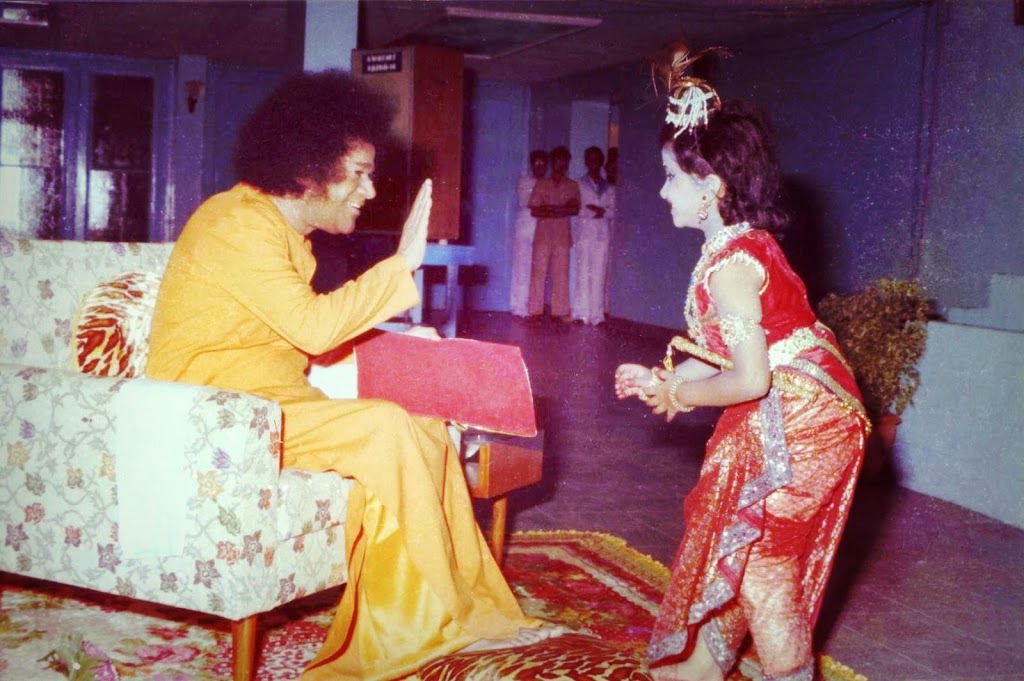Hare Rama Hare Rama Rama Rama Hare Hare-2.52-1996 July 12
Slow Tempo
Hare Rama Hare Rama Rama Rama Hare Hare
Hare Krishna Hare Krishna Krishna Krishna Hare Hare
Sathsangatve Nissangatvam Nissangatve Nirmohatvam
Nirmohatve Nischalatatvam Nischalatatve Jeevanmukti
Fast Tempo
Hare Rama Hare Rama Rama Rama Hare Hare
Hare Krishna Hare Krishna Krishna Krishna Hare Hare
Super Fast Tempo
Hare Rama Hare Rama Rama Rama Hare Hare
Closing line
Hare Krishna Hare Krishna Krishna Krishna Hare Hare
Hare Hare
12 July 1996
Meaning of the Bhajan
Hare Rama Hare Rama Rama Rama Hare Hare
Hare Krishna Hare Krishna Krishna Krishna Hare Hare
Hare is the vocative of Hari (a way of addressing Hari / God)
Sathsangatve Nissangatvam Nissangatve Nirmohatvam
From Satsangha(association with the Truth/good and virtuous company), comes Nissangha (non-attachment); from non-attachment comes Nirmoha (freedom from delusion).
Nirmohatve Nischalatatvam Nischalatatve Jeevanmukti
Being free from delusion, leads to Nischalatatva (unwavering or steady mind/experience of the unwavering principle). From an unwavering mind/experience of the unwavering principle, comes Jivan Mukti (liberation).
Source of the last two lines of the Bhajan:
This is the 9th stanza of the Bhaja Govindam stotram, which is a bouquet of 31 stanzas. Of them, 13 stanzas are composed by Sri Adi Sankaracharya, while the rest are attributed to his disciples.
Govinda Krishna Jai Gopala Krishna Jai-3.52-1990 May 30

Slow Tempo
Govinda Krishna Jai, Gopala Krishna Jai, Gopalabalabala Radha Krishna Jai (2)
Krishna Jai, Krishna Jai, Krishna Jai, Krishna Krishna Krishna Krishna Jai (2)
Gopikamaala Haari Pyaari, Mai Meera Mana Vihaari, Madana Mohana Muralidhaari, Krishna Jai (2)
Krishna Jai, Krishna Jai, Krishna Jai, Krishna Krishna Krishna Krishna Jai
Krishna Jai, Rama Krishna Jai, Radha Krishna Jai, Baala Krishna Krishna Krishna Krishna Jai
Krishna Jai, Krishna Jai, Krishna Jai, Krishna Jai, Krishna Krishna Krishna Krishna Jai
Fast Tempo
Govinda Krishna Jai, Gopala Krishna Jai, Gopalabalabala Radha Krishna Jai
Krishna Jai, Krishna Jai, Krishna Jai, Krishna Krishna Krishna Krishna Jai
Gopikamaala Haari Pyaari, Mai Meera Mana Vihaari, Madana Mohana Muralidhaari, Krishna Jai
Krishna Jai, Krishna Jai, Krishna Jai, Krishna Jai, Krishna Krishna Krishna Krishna Jai
Closing line
Govinda Krishna Jai, Gopala Krishna Jai, Gopalabalabala Radha Krishna Jai
30 May 1990
Meaning of the Bhajan
Govinda Krishna Jai Gopala Krishna Jai Gopalabalabala Radha Krishna Jai
Glory to Lord Govinda Krishna, Glory to Lord Gopala Krishna, Glory to the little child Krishna and the little child Radha
Krishna Jai, Krishna Jai, Krishna Jai, Krishna Krishna Krishna Krishna Jai
Glory to Lord Krishna
Gopikamaala Haari Pyaari, Mai Meera Mana Vihaari, Madana Mohana Muralidhaari, Krishna Jai
The One adorned with the beautiful garland made by the Gopikas (cowherd women), the One residing in the mind of Mother Meera (the saint), the delightful and attractive bearer of the flute, Glory be to you!
Krishna Jai, Rama Krishna Jai, Radha Krishna Jai, Baala Krishna Krishna Krishna Krishna Jai
Glory to Lord Krishna, Rama; Glory to Lord Krishna, Radha; Glory to Lord Krishna, the little One; Glory to Lord Krishna
Om Sriram Jairam Jai Jai Ram-2.14-1982 November 22

Slow Tempo
Om Sriram Jairam Jai Jai Ram (2)
Om Sriram Jairam Jai Jai Ram (High)
Om Sriram Jairam Jai Jai Ram
Sitaram Sitaram Sitaram
Radheshyam Radheshyam Radheshyam
Fast Tempo
Om Sriram Jairam Jai Jai Ram
Om Sriram Jairam Jai Jai Ram (High)
Om Sriram Jairam Jai Jai Ram
Om Sriram Jairam Jai Jai Ram (2) (Double High)
Om Sriram Jairam Jai Jai Ram (2)
Closing line
Om Sriram Jairam Jai Jai Ram
22 November 1982
Meaning of the Bhajan
Om Sriram Jairam Jai Jai Ram
Om Lord Rama, Glory to Lord Rama
Sitaram Sitaram Sitaram
Sita the consort of Lord Rama and Lord Rama
Radheshyam Radheshyam Radheshyam
Radha the beloved of Lord Krishna (also known as Shyam) and Lord Krishna
Shuklaambaradaram Ganapati Mantram-3.21-1985 September 18
Shuklaambaradaram Ganapati Mantram (2)
Nityam Nityam Bhajo Bhajo (2)
Vighna Vinaashaka Vishwam Vyaapaka (2)
Veera Ganapati Bhajo Bhajo (2)
Fast Tempo
Shuklaambaradaram Ganapati Mantram (2)
Nityam Nityam Bhajo Bhajo (2)
Vighna Vinaashaka Vishwam Vyaapaka (2)
Veera Ganapati Bhajo Bhajo (2)
Shuklaam Baradaram Ganapati Mantram
Nityam Nityam Bhajo Bhajo………
Closing line
Shuklaambaradaram Ganapati Mantram
Nityam Nityam Bhajo Bhajo
18 September 1985
Meaning of the Bhajan
Shuklaambaradaram Ganapati Mantram
The Bhajan refers to the Ganapati Mantra:
Shukla-Ambara-Dharam Vishnnum Shashi-Varnnam Chatur-Bhujam |
Prasanna-Vadanam Dhyaayet Sarva-Vighnopa-Upashaantaye ||
Shukla (white) Ambara (dress or sky) Dharam (dons); means the one who dons white robes or alternatively the one who dons the white sky as His robe.
Nityam Nityam Bhajo Bhajo
Sing the glory every day, continuously
Vighna Vinaashaka Vishwam Vyaapaka
The remover of obstacles; the one who pervades the entire universe
Veera Ganapati Bhajo Bhajo
Sing the glory of the valorous Ganesha
Hey Shiva Shankara Namaami Shankara-2.10-1998 April 26
Slow Tempo
Hey Shiva Shankara Namaami Shankara Shiva Shankara Shambho (2)
Hey Girijaapati Bhavaani Shankara (2)
Bhavaani Shankara
Hara Bhavaani Shankara
Shiva Shankara Shambho (High)
Shiva Shankara Shambho (Medium)
Shiva Shankara Shambho (Low)
Fast Tempo
Hey Shiva Shankara Namaami Shankara Shiva Shankara Shambho
Closing line
Hey Girijaapati Bhavaani Shankara
Shiva Shankara Shambho (High)
Shiva Shankara Shambho (Medium)
Shiva Shankara Shambho (Low)
26 April 1998
Meaning of the Bhajan
Shiva, Shankara, Shambho
Different names for Lord Iswara
Namaami
Salutation
Girijaapati
Lord Shiva, the consort of Girija (Goddess Parvati)
Bhavaani Shankara
Lord Shiva, the consort of Bhavani (Goddess Parvati)
Vahe Guru Vahe Guru Vahe Guruji Bolo-3.14-1973 June 01
Waheguru Waheguru Waheguruji Bolo (2)
Satnaam Satnaam Satnaam-Ji Bolo
Bolo-Satnaam Satnaam Satnaam-Ji Bolo
Nityan Nityan Japiye Tere Naamji Bolo
Satnaam Satnaam Satnaam-Ji Bolo
Ram Ram Ram Ram Ram Ram-Ji Bolo
Bolo-Rama Rama Rama Rama Rama Rama-Ji Bolo
Satnaam Satnaam Satnaam-Ji Bolo
Krishna Krishna Krishna Krishna Krishna Krishna-Ji Bolo
Bolo-Krishna Krishna Krishna Krishna Krishna Krishna-Ji Bolo
Nityan Nityan Japiye Krishna Naamji Bolo
Hari Hari Hari Hari Hari Hari-Ji Bolo
Bolo-Hari Hari Hari Hari Hari Hari-Ji Bolo
Satnaam Satnaam Satnaam-Ji Bolo (2)
Govinda Jai Jai Gopaala Jai Jai (2)
Raadha Ramana Hari Govinda Jai Jai
Govinda Jai Jai Gopaala Jai Jai (2) (Low scale)
Govinda Jai Jai Gopaala Jai Jai (Medium scale)
Bolo-Govinda Jai Jai Gopaala Jai Jai
Govinda Jai Jai Gopaala Jai Jai (High scale)
Bolo-Govinda Jai Jai Gopaala Jai Jai
Raadha Ramana Hari Govinda Jai Jai
Fast Tempo
Waheguru Waheguru Waheguruji Bolo
Bolo- Waheguru Waheguru Waheguruji Bolo
Satnaam Satnaam Satnaamji Bolo
Closing line
Satnaam Satnaam Satnaamji Bolo
01 June 1973
Meaning of the Bhajan
Waheguru Waheguru Waheguruji Bolo
Chant the name of God
(Waheguru also transliterated as Vahiguru is a term most often used in Sikhism to refer to God, the Supreme Being or the creator of all. It means “Wonderful Teacher” in the Punjabi language, but in this case is used to refer to God)
Satnaam Satnaam Satnaam-Ji Bolo
Chant the name of Satnaam (true name)
(Satnaam is again another word used in the Guru Granth Sahib to refer to God. Yet other words are: Onkar, Satguru, etc.)
Nityan Nityan Japiye Tere Naamji Bolo
Let us chant His Name everyday
Ram Ram Ram Ram Ram Ram-Ji Bolo
Chant the name of Rama
Satnaam Satnaam Satnaam-Ji Bolo
Chant the name of Satnaam (true name)
Krishna Krishna Krishna Krishna Krishna Krishna-Ji Bolo
Chant the name of Krishna
Nityan Nityan Japiye Krishna Naamji Bolo
Let us chant the name of Krishna everyday
Hari Hari Hari Hari Hari Hari-Ji Bolo
Chant the name of Hari (Vishnu)
Satnaam Satnaam Satnaam-Ji Bolo
Chant the name of Satnaam (true name)
Govinda Jai Jai Gopaala Jai Jai
Govinda (Krishna, the Divine Cowherd), Glory, Glory; Gopala (Krishna, the Caretaker of cows), Glory, Glory
Raadha Ramana Hari Govinda Jai Jai
Radha Ramana Hari (The Divine Mother, spouse of Krishna), Glory, Glory; Govinda, Glory, Glory
Bhaja Govindam Bhaja Govindam-2.03-1973 May 30

















